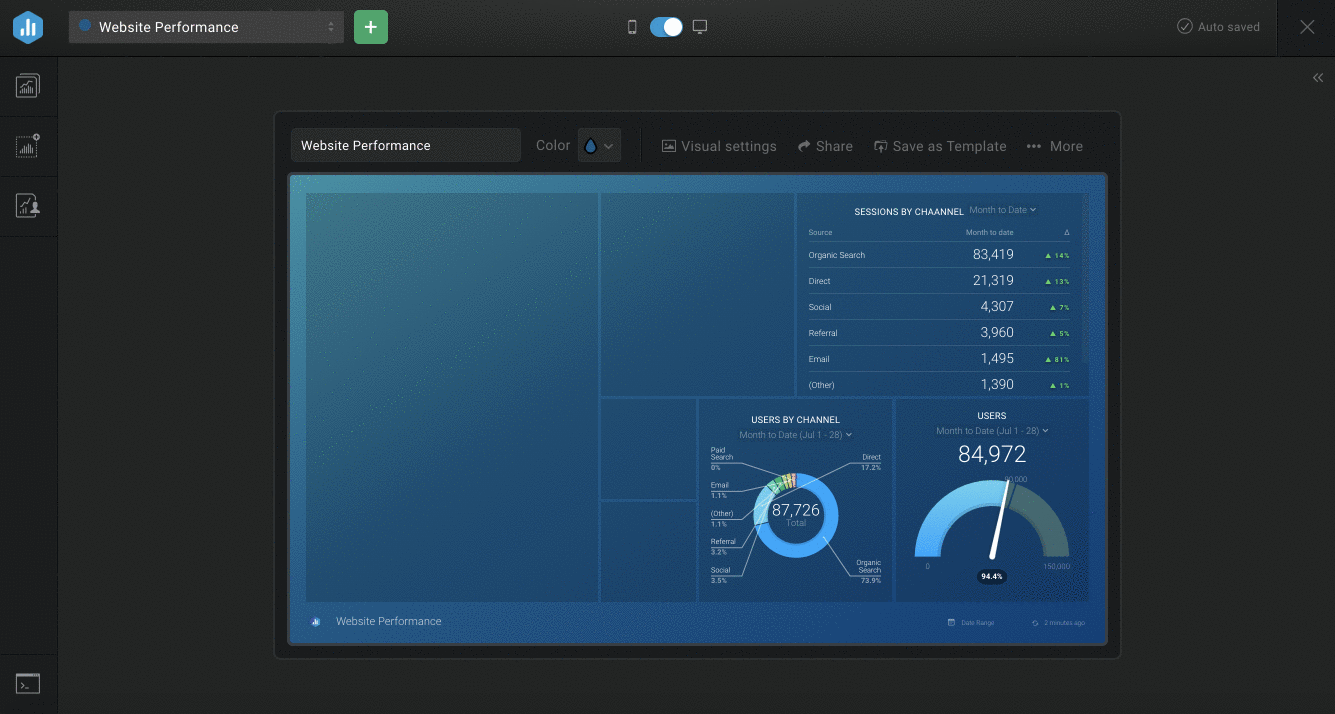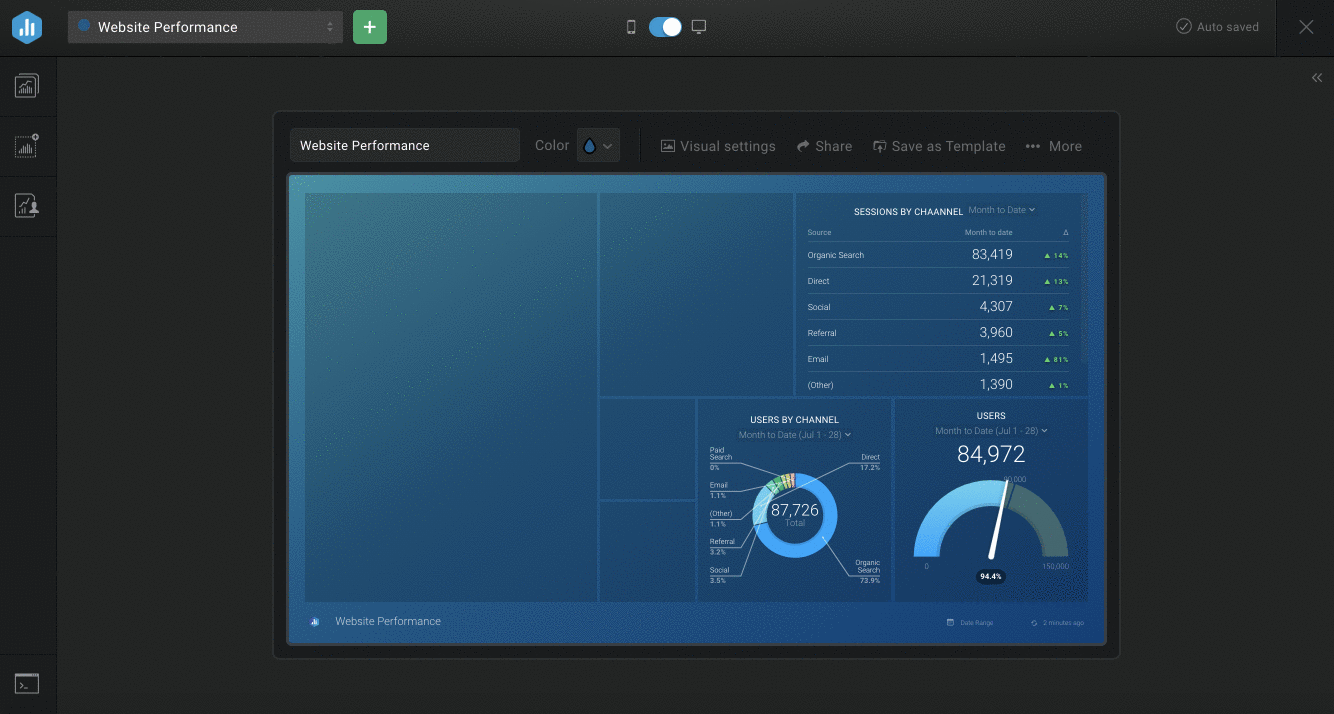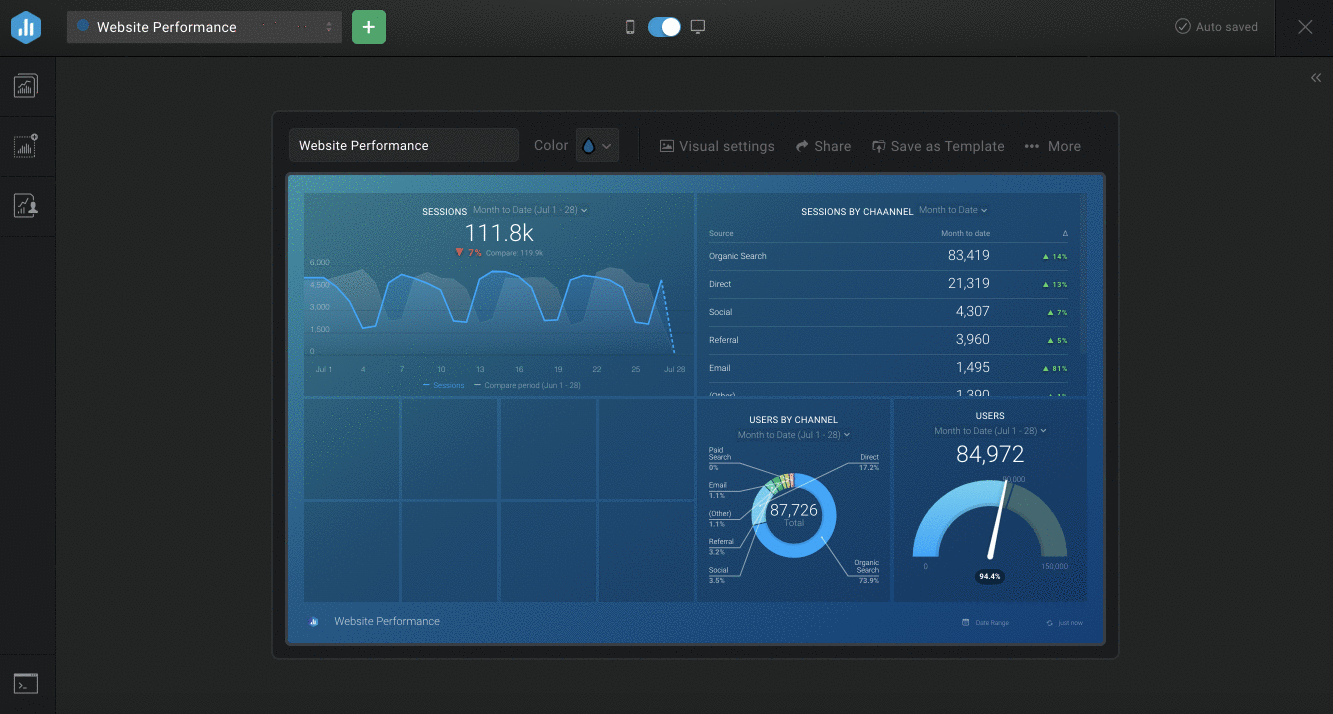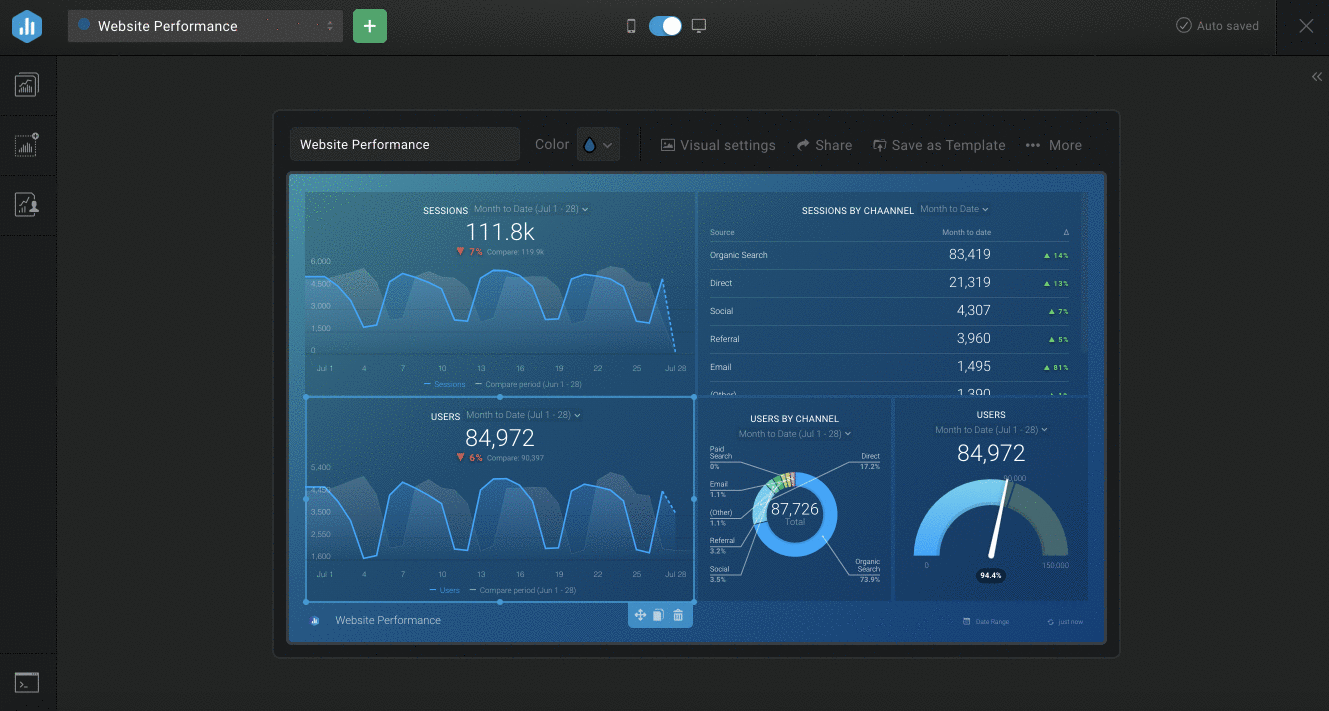Overview: Designer
The Designer gives you the ability to customize your Databoards and the data that is populating them. In this document, we will take a closer look at the Designer and the individual components that make it up.
如何访问设计师
如何创建一个空白数据库

Navigate to theDataboards页。单击green+新数据库右上方的按钮。选择开始空白to create a new, blank Databoard in the Designer.
How to edit an existing Databoard in the Designer

Navigate to theDataboards页。悬停在要编辑并单击的数据库上Edit.This will open the Databoard in the Designer.
How to customize and brand your Databoard

A
数据库标题: Enter a title for your Databoard. This will appear in the bottom left corner of the Databoard.
B
Color: From the Color drop-down you can choose from 18 pre-defined Databoard background colors for your Databoard. At the bottom of the drop-down you can also select a Chart Theme for the Databoard.
图表将显示主题的颜色for lines on Line Charts, bars on Bar Charts, slices in a Pie Chart, etc. Chart Theme options are dependent on the background color that is selected for your Databoard.
C
Advanced Visual Settings:从“高级视觉设置”窗口中,您可以通过在右下角或背景图像上传徽标来进一步为数据库提供烙印。
D
Desktop vs Mobile View: Use the toggle to switch between Desktop and Mobile views. All Databoards are optimized for both Desktop and Mobile use.
Pro Tip:大多数用户选择通过自定义桌面版本开始,因为还有更多自定义选项。
E
Share Databoard: Open the
Share Databoardwindow by clicking on the arrow icon. From here you can access the Sharable Link, Schedule Snapshots of the Databoard, get the HTML code for the Databoard so you can embed the live Databoard on a website, or invite teammates to Databox.
F
Save as Template:将您的数据保存作为一个
帐户模板so it's easily available for future use.
G
更多的: From the更多的drop-down you can duplicate the Databoard, open the Shareable Link by clicking全屏视图,最喜欢的数据库,因此已添加到您的Home屏幕,标记数据库,更改权限User Access,或删除数据库。
编辑数据库时,所有更改都将自动保存。当数据库保存时,它会说Saving在右上角。一旦保存数据库,它将说Saved在右上角。
如何在数据库中添加数据库
How to use the Metric Library
公制库由3,000多个基于常用的指标和可视化类型的预构建数据库组成,可帮助您更快地构建新数据库。

1点击公制图书馆icon on the lefthand side of the Designer.
2Choose the Data Source you want to add to the Databoard from the Data Source drop-down list.
3Search for a pre-built Datablock that reports on the data you're looking for, using theSearchbar if necessary.
4将所选数据库从公制库拖放到您的数据库。这将自动填充您所选数据源的数据。它还将根据最受欢迎的用例,使用DataBlock标题,可视化类型,日期范围等。
Pro Tip: Once the Datablock is on your Databoard, you can use theDatablock Editor自定义DataBlock以满足您的特定需求。
5To add another Datablock to the Databoard, navigate back to the
公制图书馆and choose the next Datablock that you want to add to your Databoard. Or, try out
another strategyfor adding Datablocks to your Databoard.
Pro Tip: Each Datablock is completely unique from all other Datablocks on the Databoard.
6将选定的数据存储拖放到您的数据库。
7
重复要添加到数据库的剩余数据Bocks的过程。
如何使用可视化库
如果要从空白数据库开始,则可以将空白可视化类型拖放到数据库中。然后,您可以更新DataBlock编辑器以将该数据库映射到特定的数据源和度量标准,选择最重要的日期范围,更改比较期限等等。

1点击可视化类型icon on the lefthand side of the Designer.
2Find the visualization you want to add to your Databoard. Drag and drop the selected visualization from the Visualization Library to your Databoard. This will automatically produce a blank Datablock on your Databoard.
3单击DataBlock打开Datablock Editor在设计师的右侧。从这里,您可以选择数据源的数据源,指标,日期范围和数据源的其他自定义选项。
Pro Tip:设置数据库时,您仅选择每个Datablock的1个日期范围。这是主要日期范围,或者数据库自然加载到的日期范围。在查看数据库时,您将能够选择其他日期范围。
4To add another Datablock to the Databoard, navigate back to
可视化类型sand choose the next visualization that you want to add to your Databoard. Or, try out
another strategyfor adding Datablocks to your Databoard.
Pro Tip: Each Datablock is completely unique from all other Datablocks on the Databoard.
5将选定的数据存储拖放到您的数据库。Customize the Datablock using theDatablock Editoron the righthand side.
6
重复要添加到数据库的剩余数据Bocks的过程。
How to use My Metrics
当您将指标添加到您的指标屏幕,您会看到它们在My Metrics. This helps align your team around the right Metrics and makes it easier than ever to use these Metrics on Databoards.

1点击My Metricsicon on the lefthand side of the Designer.
2Enter the name of a Metric or Tag in theSearchbar to find the Metric you're looking for.
3单击visualization您想添加到数据库的度量标准的左侧图标。为您的度量选择一个可视化,然后将数据库拖放到数据库。
4单击DataBlock打开Datablock Editor在设计师的右侧。从这里,您可以选择数据源的数据源,指标,日期范围和数据源的其他自定义选项。
5To add another Datablock to the Databoard, navigate back to
My Metricsand choose the next visualization that you want to add to your Databoard. Or, try out
another strategyfor adding Datablocks to your Databoard.
Pro Tip: Each Datablock is completely unique from all other Datablocks on the Databoard.
6将选定的数据存储拖放到您的数据库。Customize the Datablock using theDatablock Editorpanel.
7
重复要添加到数据库的剩余数据Bocks的过程。
How to move, resize, duplicate, and delete Datablocks on your Databoard
如何在数据库上移动数据锁

1在里面设计师,单击您要移动的数据库
2在Datablock的底部,单击移动块icon
3拖动光标以移动DataBlock
Pro Tip: The size of other Datablocks on your Databoard may automatically re-adjust to make room for the Datablock.
如何在数据库上调整数据大小

1在里面设计师, click on the Datablock that you want to resize
2将光标沿DataBlock的边缘放置,该数据Blue以蓝色概述。这将使您的光标变成箭头
3点击edge of the Datablock and drag your cursor to resize the Datablock
Pro Tip: The size of other Datablocks on your Databoard may automatically re-adjust to make room for the resized Datablock.
How to duplicate Datablocks on your Databoard

1在里面设计师, click on the Datablock that you want to duplicate
2在Datablock的底部,单击复制Blockicon
3On the复制Datablockwindow, select the Databoard where you would like to duplicate the Datablock to. This can be a new Databoard, the Databoard the Datablock is already on, or another Databoard in your Account
4单击绿色复制button
Pro Tip
:您的数据库上其他数据库的大小可能会自动重新调整,以腾出空间为新的Datablock腾出空间。
How to delete Datablocks from your Databoard

Pro Tip: Deleting Datablocks is irreversible.
1在里面设计师,单击要删除的数据库
2在Datablock的底部,单击Remove Blockicon
3ClickYes, Delete在确认窗口上以从数据库中删除数据库
How to use Datablock Editor to customize your Datablocks
了解如何使用DataBlock编辑器自定义数据库这里.










